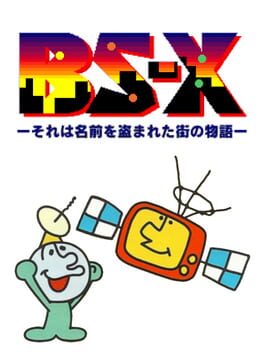

BS-X: Sore ha Namae wo Nusumareta Machi no Monogatari
Bundled with the Satellaview system. The application on this cartridge took the form of a game; however, its actual purpose was to serve as an interactive menu system for the console subunit. On start-up the player would enter a name, selected either a male or female character avatar, and then move the avatar around a virtual town. Houses and shops in the town served as download locations where the player could directly download games, particular game data, or digital magazines. The download would write game data into temporary memory locations which would remain until the player downloaded a new game to take its place. Apart from downloads, players could also travel to in-game locations such as the Wall Newspaper Co. (かべ新聞社 kabe shinbunsha?) to read brief text-only postcard-like messages from St.GIGA and Nintendo that announced contest winners, revealed future games and future programming schedule details, and served to raise awareness for celebrity events relating to SoundLink Magazine performers' off-Satellaview activities. Furthermore, the avatar was equipped with an inventory and game currency which could be spent on various in-game items such as telephone cards, vehicle tickets, fish bait, and shoes that would enable the player to dash rather than walk everywhere. While the BS-X application cartridge had none of the challenges typically associated with games, it featured a plot of sorts and thus can be considered a video game in a narratalogical sense.
Reviews View More
The Satellaview is an oddity that I've always found deeply charming but have unfortunately never had the opportunity to experience myself. If you're not familiar, Nintendo developed a satellite modem add-on for the Super Famicom alongside broadcasting company St.GIGA. Released in 1995, it connected to the bottom of the console and gave subscribers access to all sorts of content - primarily games, and you could keep one downloaded and stored until you replaced it. But you could also access popular gaming and news publications of the time such as Famitsu, as well as audio broadcasts ranging from music to celebrity interviews. (You might have gleaned as much from the blurb up above.) There were even games designed to have live voice acting provided during gameplay. Yes, live! Can you imagine? It's the kind of thing that, unless somebody had the foresight to record it, could only be experienced once. Eat your heart out, Amazon Luna. Of course, the Satellaview had remarkable third-party support for the time, and there were games released for it that have never been re-released (and some that have been, though not in quite the same form). Some noteworthy examples are a remake of the original The Legend of Zelda and a sequel of sorts to A Link to the Past, as well as the first release of Radical Dreamers, which served as a "bridge" between Chrono Trigger and Chrono Cross. I'm not really here to talk about any of that, though. I want to talk about the Satellaview itself and how it presented itself to the player.
Upon booting up for the first time, you'd be greeted by a talking TV who would ask you for your name. After this brief introduction, you'd be dumped into a little city that positively smacks of Mother/Earthbound. All around you were buildings that weren't just for show: While some were there to provide services to the player character, others served as gateways into the Satellaview's various features. A hub level, if you will. This contextualization of a console's menus as a physical location to explore is absolutely adorable and if it's been done elsewhere, I'm struggling to think of examples. Of course, while not being especially game-y on its own, you do have an inventory and currency and can purchase items or upgrades for your character. There's ostensibly a plot of some kind to follow; I'm not totally sure what it is myself, but if the name is anything to go by, I'd assume it involves a town that had its name stolen. It even comes with a sweet little OST of its own! It's an outrageously cool concept, and I'd love to see somebody pick it up and go even further with it. How about some kind of Animal Crossing-style life sim that likewise runs on the system's internal clock? You could decorate your house with goodies from games you've played and visit the houses of friends you've added, which might show up in your own personal town. Maybe you could freely move buildings around for ease of access and get everything set up just the way you like it. I'm not gonna spend all day dreaming about it, but it has a ton of potential. Of course, I reckon it's fair to assume that most devs would pass on it simply because of how much effort would need to go into it when a simple menu interface would suffice. But it would do a ton to add to the charm of a device, especially considering how dull systems like the Switch are before you actually launch some software.
Sadly, just getting your hands on an old Satellaview system and plugging it in won't avail you of much. Nintendo's relationship with St.GIGA soured towards the end of the add-on's lifetime and the service was ended about five years after its launch. St.GIGA itself went bankrupt and was absorbed into Japanese media company WireBee. There's nothing to find on the air anymore, and even if there was, there were so many one-time broadcasts that you'd never get the full experience. Hasn't stopped people from trying to restore what they can, because of course it hasn't. Whether it's the BIOS or the games themselves, there are still ways you can recapture that magic, even if only for a moment. As always, I salute those who are so dedicated to preserving the past - because there's so much I'd miss out on if not for them.
